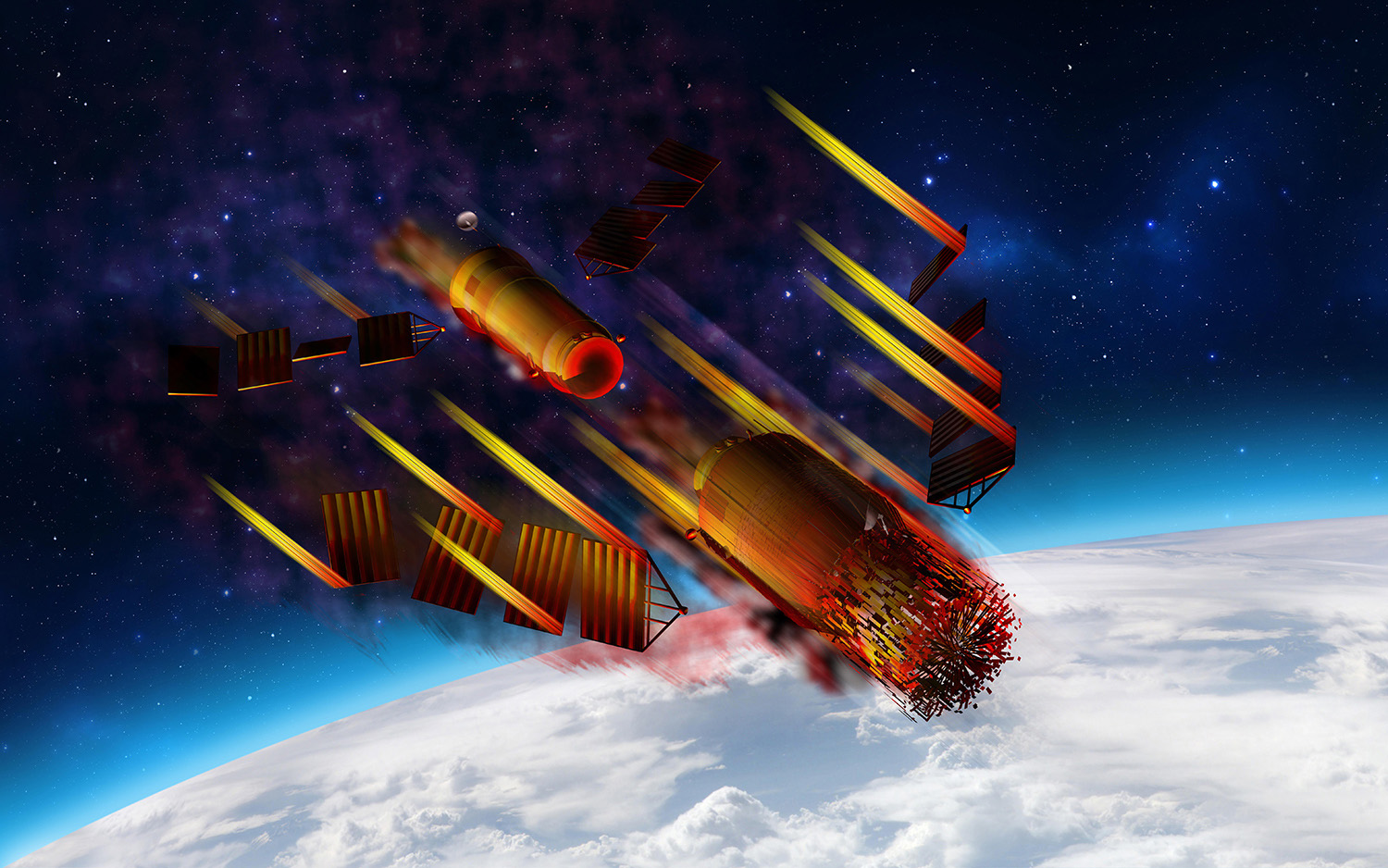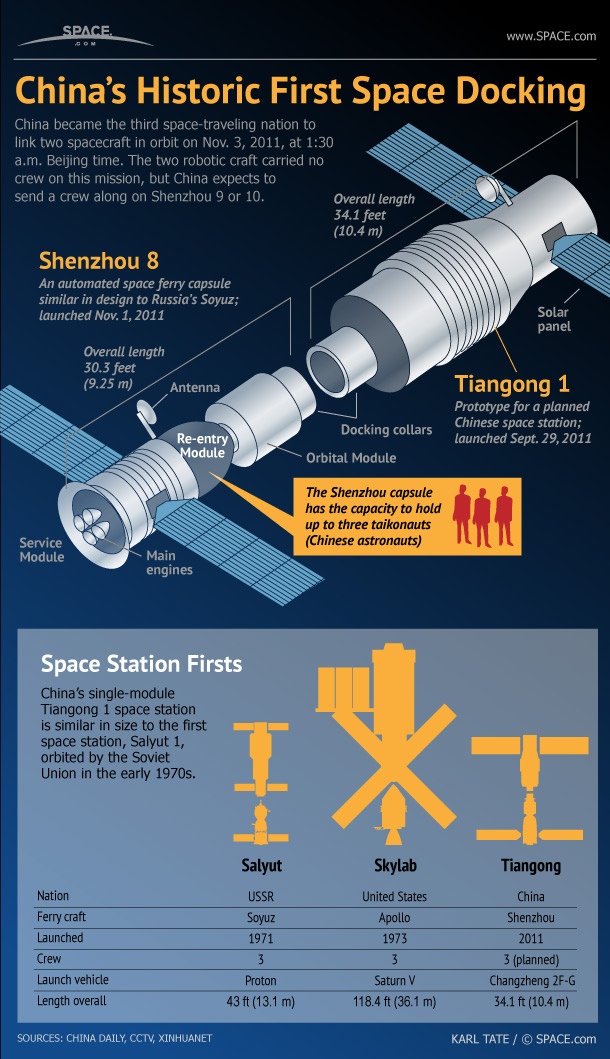Farewell, Tiangong-1: Chinese Space Station Meets Fiery Doom Over South Pacific

Tiangong-1 is no more.
China's prototype space station, whose name translates as "Heavenly Palace 1," met a fiery end in Earth's atmosphere today (April 1), breaking apart and burning up in the skies over the southern Pacific Ocean at about 8:16 p.m. EDT (0016 April 2 GMT), according to the U.S. Strategic Command's Joint Force Space Component Command (JFSCC).
"The JFSCC used the Space Surveillance Network sensors and their orbital analysis system to confirm Tiangong-1's re-entry," U.S. Air Force officials wrote in a statement. [Tiangong-1: China's Falling Space Station in Pictures]
Some pieces of the school-bus-size Tiangong-1 almost certainly survived the fall, but the odds that they caused any damage or injury are extremely small: You had a less than 1-in-1-trillion chance of getting hit by a flaming chunk of the heavenly palace, according to experts with the Aerospace Corporation.
By the way, if you do manage to find such a chunk of Tiangong-1, don't pick it up or breathe in any fumes emanating from it. The space junk may be contaminated with hydrazine, a toxic rocket fuel, experts have said.
Tiangong-1 was about 34 feet long by 11 feet wide (10.4 by 3.4 meters), and it weighed more than 9 tons (8 metric tons). The space lab consisted of two main parts: an "experimental module" that housed visiting astronauts and a "resource module" that accommodated Tiangong-1's solar-energy and propulsion systems.

The craft launched without anyone aboard on Sept. 29, 2011, to an orbit about 217 miles (350 kilometers) above Earth. That's slightly lower than the orbit of the much larger International Space Station, whose average altitude is 250 miles (400 km). Tiangong-1's main mission was to help China master the technologies required to assemble and operate a bona-fide space station in Earth orbit, a goal the nation aims to achieve by the early 2020s, the country has said.
Get the Space.com Newsletter
Breaking space news, the latest updates on rocket launches, skywatching events and more!
On Nov. 2, 2011, the robotic Shenzhou-8 spacecraft visited Tiangong-1, executing China's first-ever orbital docking. Another big milestone came in June 2012, when a crew of three spaceflyers linked their Shenzhou-9 vehicle to the heavenly palace and came aboard for a spell.
Three more "taikonauts," or Chinese astronauts, visited in June 2013, traveling on the Shenzhou-10 spacecraft. Each of these crewed missions lasted about two weeks.
Tiangong-1's design lifetime was just two years, and the space lab's work was mostly done after Shenzhou-10 departed. The empty space lab continued to do some Earth-observation work, however, and researchers and engineers kept in touch with it until March 2016, when data transmission between Tiangong-1 and its handlers stopped, for reasons that China never explicitly specified. At that point, an uncontrolled atmospheric re-entry was apparently inevitable.
This is the view of outside researchers. But Chinese space officials dispute such terminology, said Dean Cheng, a senior research fellow at The Heritage Foundation who's an expert on China's space program. [The Biggest Spacecraft to Fall Uncontrolled From Space]
"The Chinese insist that it is controlled," Cheng told Space.com. "They're very, very unhappy when you use this term 'uncontrolled.'"
Chinese officials have said that they know where Tiangong-1 is and can provide location updates at any time, Cheng added. But for other spacefaring nations, a "controlled" re-entry is one performed under the guidance of a spacecraft's handlers — for example, the intentional de-orbiting of the Soviet/Russian Mir space station over the Pacific Ocean in March 2001.
"We should be diplomatically, and in the space-policy world, pushing China to accept a definition of 'control' that is comparable to that of the rest of the rules-based world. You don't get your own definition," Cheng said. "To support that, there need to be some sticks here," he added, referring to consequences.
The re-entry of Tiangong-1 was tracked by the JFSCC, the U.S.-based analysis group Aerospace Corp., the European Space Agency and scientists around the world with the Inter-Agency Space Debris Coordination Committee.
"The JFSCC works alongside government, industry and international partners to track and report reentries, to include today’s Tinagong-1 reentry, because the space domain is vital to our shared international security interests," JFSCC deputy commander Maj. Gen. Stephen Whiting, commander of the 14th Air Force, said in the JFSCC statement. "One of our missions, which we remain focused on, is to monitor space and the tens of thousands of pieces of debris that congest it, while at the same time working with allies and partners to enhance spaceflight safety and increase transparency in the space domain."
Tiangong-1's successor, Tiangong-2, launched to Earth orbit in September 2016 and hosted three visiting astrpnauts a month later. And a robotic vessel called Tianzhou-1 rendezvoused with Tiangong-2 a few months later, performing several automated docking and refueling operations from April 2017 to September 2017.
The success of these missions apparently has China poised to start building a permanent space station. The nation aims to begin construction and assembly operations next year, and the first crewed missions to the outpost could come in 2022, Chinese space officials have said.
Tiangong-1 is not the biggest spacecraft ever to fall from the sky. That distinction goes to the 140-ton (127 metric tons) Soviet/Russian space station Mir, which was guided to a controlled destruction over the Pacific Ocean in March 2001.
The largest craft ever to come down at least partially uncontrolled is NASA's 100-ton (91 metric tons) space shuttle Columbia, which broke apart as it was returning to Earth on Feb. 1, 2003, killing all seven astronauts aboard. An investigation later pinned the cause of the disaster on a piece of foam insulation from Columbia's external fuel tank, which broke off and punched a hole in the heat shield on the orbiter's left wing during launch, two weeks before the tragedy.
Follow Mike Wall on Twitter @michaeldwall and Google+. Follow us @Spacedotcom, Facebook or Google+. Originally published on Space.com.
Join our Space Forums to keep talking space on the latest missions, night sky and more! And if you have a news tip, correction or comment, let us know at: community@space.com.

Michael Wall is a Senior Space Writer with Space.com and joined the team in 2010. He primarily covers exoplanets, spaceflight and military space, but has been known to dabble in the space art beat. His book about the search for alien life, "Out There," was published on Nov. 13, 2018. Before becoming a science writer, Michael worked as a herpetologist and wildlife biologist. He has a Ph.D. in evolutionary biology from the University of Sydney, Australia, a bachelor's degree from the University of Arizona, and a graduate certificate in science writing from the University of California, Santa Cruz. To find out what his latest project is, you can follow Michael on Twitter.









